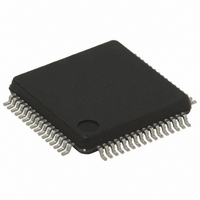ST72F321BR9T6 STMicroelectronics, ST72F321BR9T6 Datasheet - Page 88

ST72F321BR9T6
Manufacturer Part Number
ST72F321BR9T6
Description
MCU 8BIT 60KB FLASH/ROM 64-LQFP
Manufacturer
STMicroelectronics
Series
ST7r
Datasheet
1.ST72F321BK6T6.pdf
(187 pages)
Specifications of ST72F321BR9T6
Core Processor
ST7
Core Size
8-Bit
Speed
8MHz
Connectivity
I²C, SCI, SPI
Peripherals
LVD, POR, PWM, WDT
Number Of I /o
48
Program Memory Size
60KB (60K x 8)
Program Memory Type
FLASH
Ram Size
2K x 8
Voltage - Supply (vcc/vdd)
3.8 V ~ 5.5 V
Data Converters
A/D 16x10b
Oscillator Type
Internal
Operating Temperature
-40°C ~ 85°C
Package / Case
64-LQFP
Processor Series
ST72F3x
Core
ST7
Data Bus Width
8 bit
Data Ram Size
2 KB
Interface Type
I2C, SCI, SPI
Maximum Clock Frequency
8 MHz
Number Of Programmable I/os
48
Number Of Timers
2
Maximum Operating Temperature
+ 85 C
Mounting Style
SMD/SMT
Development Tools By Supplier
ST7232X-EVAL, ST7232X-SK/RAIS, ST72321B-D/RAIS, ST7MDT20-DVP3, STX-RLINK
Minimum Operating Temperature
- 40 C
On-chip Adc
10 bit, 16 Channel
Cpu Family
ST7
Device Core Size
8b
Frequency (max)
8MHz
Total Internal Ram Size
2KB
# I/os (max)
48
Number Of Timers - General Purpose
2
Operating Supply Voltage (typ)
5V
Operating Supply Voltage (max)
5.5V
Operating Supply Voltage (min)
3.8V
Instruction Set Architecture
CISC
Operating Temp Range
-40C to 85C
Operating Temperature Classification
Industrial
Mounting
Surface Mount
Pin Count
64
Package Type
LQFP
For Use With
497-5046 - KIT TOOL FOR ST7/UPSD/STR7 MCU
Lead Free Status / RoHS Status
Lead free / RoHS Compliant
Eeprom Size
-
Lead Free Status / Rohs Status
Details
Other names
497-5586
Available stocks
Company
Part Number
Manufacturer
Quantity
Price
Company:
Part Number:
ST72F321BR9T6
Manufacturer:
STMicroelectronics
Quantity:
10 000
ST72321BRx, ST72321BARx ST72321BJx, ST72321BKx
10.5 SERIAL PERIPHERAL INTERFACE (SPI)
10.5.1 Introduction
The Serial Peripheral Interface (SPI) allows full-
duplex, synchronous, serial communication with
external devices. An SPI system may consist of a
master and one or more slaves however the SPI
interface can not be a master in a multi-master
system.
10.5.2 Main Features
■
■
■
■
■
■
■
■
■
Figure 54. Serial Peripheral Interface Block Diagram
88/187
Full duplex synchronous transfers (on 3 lines)
Simplex synchronous transfers (on 2 lines)
Master or slave operation
Six master mode frequencies (f
f
SS Management by software or hardware
Programmable clock polarity and phase
End of transfer interrupt flag
Write collision, Master Mode Fault and Overrun
flags
MOSI
MISO
CPU
SCK
SS
/2 max. slave mode frequency (see note)
SOD
bit
SPIDR
8-Bit Shift Register
Read Buffer
SERIAL CLOCK
CPU
GENERATOR
CONTROL
MASTER
/4 max.)
Data/Address Bus
Read
Write
Note: In slave mode, continuous transmission is
not possible at maximum frequency due to the
software overhead for clearing status flags and to
initiate the next transmission sequence.
10.5.3 General Description
Figure 54
(SPI) block diagram. There are 3 registers:
The SPI is connected to external devices through
4 pins:
– SPI Control Register (SPICR)
– SPI Control/Status Register (SPICSR)
– SPI Data Register (SPIDR)
– MISO: Master In / Slave Out data
– MOSI: Master Out / Slave In data
– SCK: Serial Clock out by SPI masters and in-
put by SPI slaves
7
SPIE
SPIF WCOL
7
SPE
shows the serial peripheral interface
CONTROL
SPR2
OVR
STATE
SPI
Interrupt
request
MODF
MSTR
CPOL
0
CPHA
SOD
SS
SPICR
SPICSR
SSM
SPR1
0
1
SPR0
SSI
0
0














